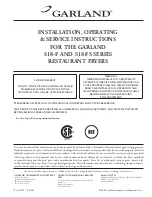
M411429
45
Section 3 Troubleshooting
To reduce the risk of electric shock, fire, explosion, serious injury or death:
• Disconnect electric power to the tumbler before servicing.
• Close gas shut-off valve to gas tumbler before servicing.
• Close steam valve to steam tumbler before servicing.
• Never start the tumbler with any guards/panels removed.
• Whenever ground wires are removed during servicing, these ground wires must be
reconnected to ensure that the tumbler is properly grounded.
W002
WARNING
© Copyright, Alliance Laundry Systems LLC – DO NOT COPY or TRANSMIT
49. CD MODELS: NO START WITH VEND SATISFIED AND START BUTTON PRESSED IN
208-240 Volt/60 Hertz/3 Phase Gas Nonreversing
NOTE: All voltage checks are referenced to neutral unless stated otherwise.
Step Problem
If No, then
1
Is there voltage to COM terminal of switch A?
If yes, continue to next step.
Correct wiring between L1 and switch A.
2
Is there voltage to the NC terminal of switch A?
If yes, continue to next step.
Check for proper operation of switch A. Replace switch
A if necessary.
3
Is there voltage to the common terminal of the door switch?
If yes, continue to next step.
Correct wiring between door switch and switch A.
4
With the door closed, is there voltage to the N.O. terminal
of the door switch? If yes, continue to next step.
Check door switch for proper operation, replace if
necessary.
5
Is there voltage to the input side of the Push-To-Start
button? If yes, continue to next step.
Correct wiring between start switch and door switch.
6
Is there voltage to the input side of the auxiliary contacts on
the motor contactor? If yes, continue to next step.
Correct wiring between motor contactor and door switch.
7
Is there voltage across the coil of the motor control
contactor?
Correct wiring between motor contactor and Push-To-
Start button.
8
If the start button is released, does the motor contactor stay
in the made position? If yes, continue to next step.
Check for proper operation of motor contactor, replace if
necessary.
9
Is there voltage to L1, L2, and L3 of the motor contactor?
If yes, continue to next step.
Correct wiring between motor contactor and L1, L2 and
L3 supply.
10
Is there voltage to T1, T2, and T3 of the motor contactor?
If yes, continue to next step.
Check for proper operation. Replace motor contactor if
necessary.
11
Is there voltage to L1, L2, and L3 of the motor?
If yes, continue to next step.
Correct wiring between motor contactor and motor.
12
Is the internal wiring of the motor correct for the supply
voltage?
Change the wiring accordingly.
13
Thermal overload cycled, allow motor to cool and recheck. Replace motor.
14
Unit operational.
















































